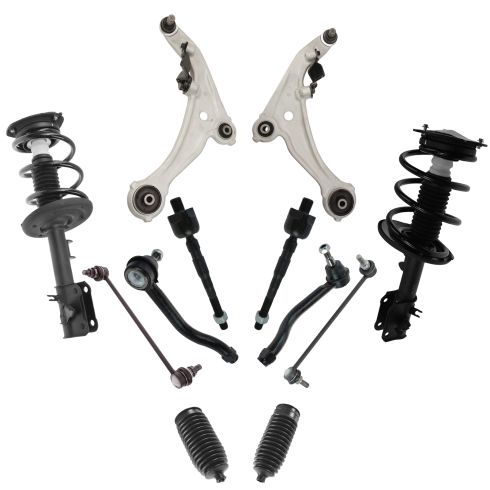1ASFK08030-Nissan Altima Front 12 Piece Steering & Suspension Kit TRQ PSA69918

Replaces
2008 Nissan Altima SE Front 12 Piece Steering & Suspension Kit TRQ PSA69918

Product Reviews
Loading reviews
5.00/ 5.0
9
9 reviews
Car parts
March 24, 2021
Love it everything was the correct parts most definitely shopping again
Excellent service and easy to shop. Thats what I like the most.
June 14, 2021
Excellent service and quality parts for a really reasonable price. I have purchase 3 suspension kits for three different vehicles and I have save a lot of money. Thank you guys ??
..
September 7, 2021
Everything is good on time delivery car runs good . Definitely would recommend it .All the parts fits perfect. I am going to order more parts from you guys.
September 17, 2021
Working great so far put on my 2010 nissan altima sl drives like new!! Good price too??
Good quality
October 14, 2021
Car is smooth now, Doesn't feel like I'm driving through a battle field everytime I drive to work.
Quality parts, Satisfied pricing.
July 12, 2022
All parts are quality parts, including self help videos from 1AAuto.
I have replaced all suspension parts on my 2010 Nissan Altima and I am satisfied with all of the above. I would definitely recommend due fair prices for parts, better that any local auto parts store.
Solid
May 11, 2023
Excellent price; Items arrived sooner than expected (awesome!) and they are the exact fit for my 2010 Nissan Altima 3.5 SR
Great parts - will return for more
July 6, 2023
Great parts - happy to say that I'll be able to keep my sweeties Nissan rolling smoothly for several more years to come! Going to be coming back to 1A auto soon for similar parts for my truck. Absolutely zero issues with fitment, alignment, or reuse of original hardware where desired.
Great Kit
May 13, 2024
Great quality and everything fit perfectly
Customer Q&A
does it fit 2012 altima COUPE 3.5 SR as well?
September 18, 2021
10
This part will not fit your vehicle, but we may have a part that is listed to fit.
Please enter your vehicle's year make and model in the search bar at the top of the page. This will display parts guaranteed to fit your vehicle. Just be sure to verify all of the information shown in the Vehicle Fit tab before ordering.
September 18, 2021
Ricale A
fit a 2012 Altima Coupe 3.5 SR as well?
September 18, 2021
10
This part will not fit your vehicle, but we may have a part that is listed to fit.
Please enter your vehicle's year make and model in the search bar at the top of the page. This will display parts guaranteed to fit your vehicle. Just be sure to verify all of the information shown in the Vehicle Fit tab before ordering.
September 18, 2021
Ricale A
Would it fit 2016 Nissan Altima?
October 14, 2021
10
It will not, it only supports 2007-2013 Nissan Altima's.
This kit I linked will fit you Nissan, it comes with the front strut assembly and the sway bars.
October 14, 2021
Roosevelt T
Will this work on 06 Nissan Altima?
November 17, 2021
10
This is not the correct part for your vehicle, but we do carry the one you need. The correct part number is: 1ASFK02352.
November 17, 2021
Emma F
Would this fit a 2011 altima SL?
June 14, 2022
10
Yes, this part will fit your vehicle.
June 14, 2022
Jessica D
I have an air suspension for my Altima coupe 2012 But wanna go back to a stock suspension. Would this be a good fit for my coupe?
September 9, 2022
10
Yes, this part will fit your vehicle.
September 9, 2022
T I
Would this kit fit a 2011 altima s?
January 17, 2023
10
Yes, this part will fit your vehicle.
January 18, 2023
Jessica D
Would this kit fit my nissan altima 2007 2.5s sedan?
January 23, 2023
10
Yes, this part will fit your vehicle.
January 24, 2023
T I
Would these parts fit a 2011Nissan Maxima ?
September 23, 2023
10
No, These parts are not listed to fit a Nissan Maxima.
September 27, 2023
Kemal S
Nissan is a registered trademark of Nissan Motor Co., Ltd. 1A Auto is not affiliated with or sponsored by Nissan or Nissan Motor Co., Ltd.
See all trademarks.

















